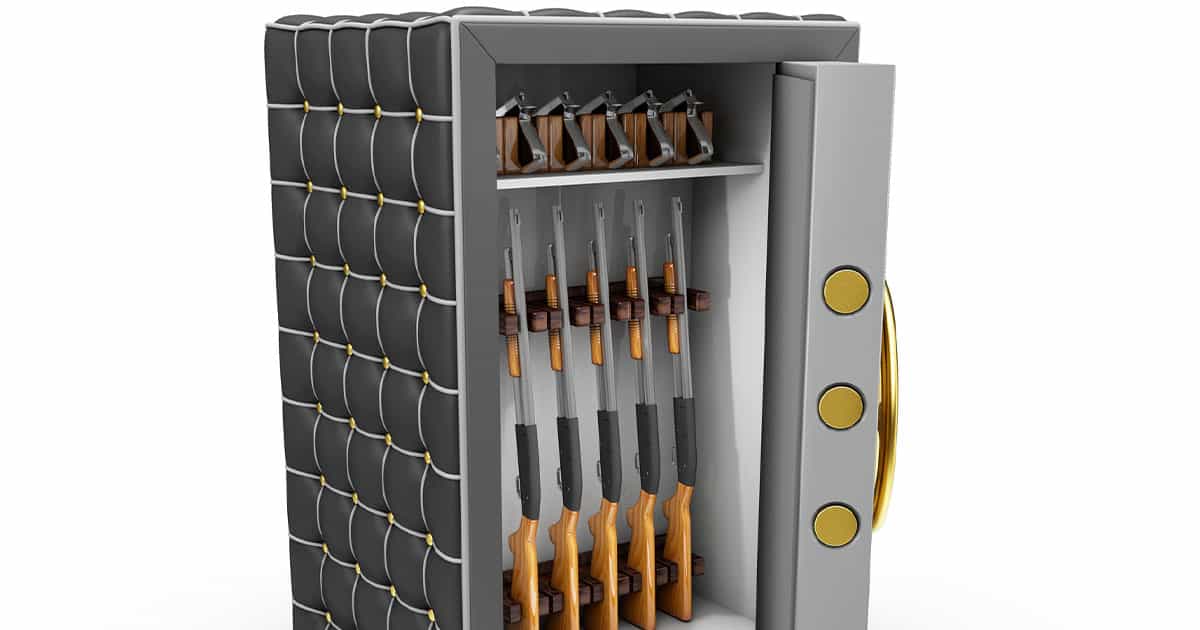An important aspect of gun ownership is the proper maintenance and storage of the guns. The USA ranks first in the number of guns owned by civilians, which was 393 million firearms in 2018. With almost 40 million guns purchased in 2020 according to FBI records, this number is now close to 450 million.
The average gun owner owns five firearms, and handguns are the most commonly owned firearm, followed by rifles, and then by shotguns. This tells us that rifles and shotguns are also owned in large numbers across the country, and since a lot of people own them, they must also be aware about keeping them secure.
Firearms cannot be left lying around unattended because if they get into the wrong hands, it could mean a fatal disaster. Additionally, proper storage is essential to avoid chances of damage and even theft.
This guide will focus upon the essentials to the secure storage of shotguns and rifles, also outlining some important considerations along the way.

Why Is Proper Gun Storage Essential?
Before we look at the solutions to securing your shotguns and rifles, it is imperative to understand the importance of doing this. Here are a few reasons to justify proper gun storage
Unauthorized Access and Theft
The first and foremost reason to secure your guns is the possibility of unauthorized access. Since the guns in question here are rifles and shotguns, there is a slightly different problem. Unlike handguns which are comparatively smaller in size and also more concealable, you cannot easily hide long guns.
There were close to a million burglaries in the United States in the year 2020, and approximately a big number of guns are stolen in the country each year. The sad part is that a majority of these stolen guns, when recovered, are found involved in criminal activities. The crux is that if a burglar enters a house and finds an unsecured firearm, it will probably be the first thing to be stolen.
Preventing Access to Kids
If you have kids in your house, leaving your firearms unattended can result in a disastrous accident. Allowing access of a firearm to an uninformed kid is a leading cause of firearm accidents involving kids.
You must also be aware that 15 states have mandated Child Access Prevention (CAP) laws. According to which, in a situation where a minor gains access to a firearm, the person responsible for securely storing the firearm will be considered legally liable.
Legal Requirements
As of now, Massachusetts and Oregon have binding laws regarding firearm storage. The law states that the firearm must be stored with a locking device (like cable locks or a trigger lock) in place when they are not in use or under the immediate control of the owner. Otherwise, the firearm must be equipped with a tamper-proof locking device. The District of Columbia has the same but non-binding policy regarding the storage of guns.
Thirteen states have laws concerning firearm locking devices, and five of these states have set standards for the design of the locking devices. Additionally, four states require firearms to be stored equipped with a locking device if the owner shares the house with a person who is ineligible to bear firearms. Some states also have laws regarding the transportation of firearms in vehicles locally or across states.
Protecting Firearm’s Finish and Function
Firearms require routine maintenance to minimize the chances of wear and tear due to climatic factors and handling. Securing your rifles and shotguns with a storage device will not only restrict access, but also ensure protection against damage. There are a few other important aspects to this, and we will understand them in detail in the upcoming section.
Preventing Accidents and Suicide
According to American Foundation for Suicide Prevention, over 85-90% of suicide attempts with firearms are fatal, and secure storage of guns can reduce suicide risk or gun violence.
Methods to Secure Your Guns
After scouring through the importance of proper gun storage, let us now check out the best methods to secure your shotguns and rifles.

Gun Safes and Gun Cabinets
The most common and easiest method for safe gun storage is the use of a gun safe, gun cabinet, or a gun vault. The difference between these two is not so huge, but it can prove differential in some situations. Such a cabinet is a locking gun cabinet that is made using thin metal sheets and is considerably lightweight.
On the other hand, a gun safe is more robust with thicker metal walls, heavier weight, and a more effective locking mechanism. It may also include other features like fire resistance, water resistance, electrical outlets, and lights.
Gun cabinets are mostly used for display of firearms at a gun shop, or the storage of one or two firearms along with documents and other valuables. Gun safes are a more reliable source of security for your firearms, and very difficult to break. If you are concerned about quick access to your firearms in case of an emergency, there are quick-access gun safes available on the market.
Concealment Furniture
An unconventional but effective method to keep your shotguns and rifles secure is the use of concealment furniture. These are normal-looking furniture items with a concealed storage space modeled inside for easy and quick access. However, such furniture generally does not feature a sturdy locking mechanism. Plus, if your kids or any unauthorized user finds out the reality of such furniture, the purpose of having it becomes vile.
Car and Truck Gun Safes
If you plan on carrying your rifle or shotgun inside your car or truck, there are gun safes available on the market which have been specially designed for this purpose. These safes come in a variety of designs and can be installed or simply placed inside your vehicle.
This is a great option to carry your long guns around, mainly when you are going to the range or visiting a gun shop. Another good option is to use long gun carry cases which can be used for transportation of your shotguns and rifles. Additionally, there are TSA approved gun cases which can be used to transport guns when traveling through airlines.

Important Aspects to Consider
After looking through the problems and their best solutions, take a look at a few sideliners to be considered before and after implementation.
Cleaning and Maintenance
If you use your rifles and shotguns on a regular basis, cleaning and maintenance is likely a part of your routine. However, for long term gun storage, you must ensure proper cleaning of your firearms before you lock them up. Since guns are made from metal, they should be properly cleaned and lubed, especially after firing.
Elements like dirt and grime can build up inside the barrel and other components, which can cause the weapon to wear and malfunction. Additionally, if your gun has wooden, polymer, or rubber components, make sure to clean and service them as well. Weapons should always be stored unloaded and possibly encased in a gun sock for maximum protection.
Keep a Check on Humidity
Excess buildup of humidity inside a closed gun safe can result in moisture on the firearms, which causes rusting of the components. If you are storing your guns for longer durations, installing a dehumidifier will be a great idea. However, if your gun safe does not have an electrical outlet for powering a dehumidifier, you can also use silica gel.
Locking Mechanism and Backup
A gun safe can either have a mechanical lock or an electrical lock. Mechanical locks can be further classified into a lock and key combo, or a dialing combination lock. Electrical locks can either be a keypad lock with a passcode, or a biometric lock that uses fingerprint.
Almost every gun safe comes with a backup key for emergencies in case you get locked out. Make sure to keep that key someplace safe and where you can find it. Biometric locks can allow you to record fingerprints of more than one user for access, so make sure the other authorized user/s are reliable. If you have the habit of forgetting things, you can save the passcode on your phone, or on a piece of paper and keep it someplace private and safe.
Location and Bolting Down
Most gun safes give you an option to bolt it down to the ground using screws. If your gun safe allows that, it is always better to get it anchored for better safety. Additionally, a gun safe must be kept at a place which is not always buzzing around with people. A corner in your garage, office, dining room, or your living room can be a good place. You can also make use of concealment covers if you cannot find an isolated spot for the safe.
Size and Capacity
Gun safes and vaults come in a variety of sizes, ranging from 4-5 long guns to being spacious enough to store up to 50 guns. The size of the safe you choose will depend upon how many guns, ammunition, and other important items in your possession. It is never a good idea to cram a gun safe to its full capacity as your guns can suffer physical damage.
Conclusion
Rifles and shotguns rank as owned in large numbers in the United States by the civilian population. Securing and storing them properly will have an impact on their service life, and it is also an ethical as well as legal responsibility of the owner. Using gun safes prevents unauthorized users from accessing your weapons, and also keeps them safe and isolated from damage.
December 12, 2022
